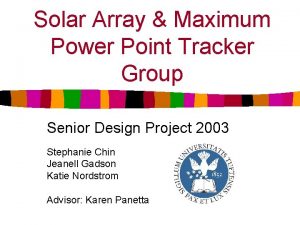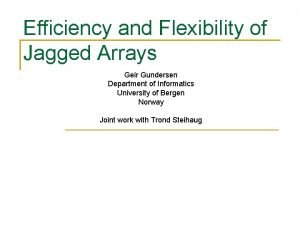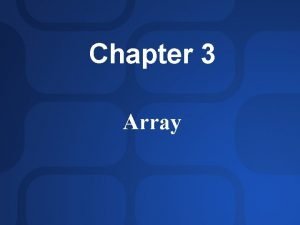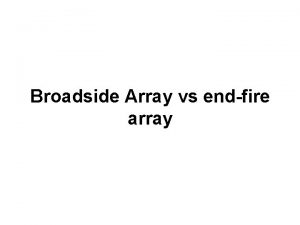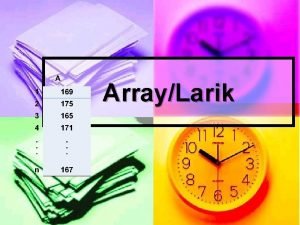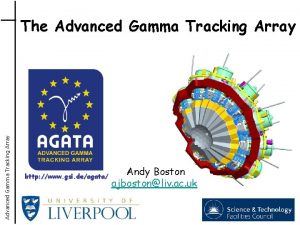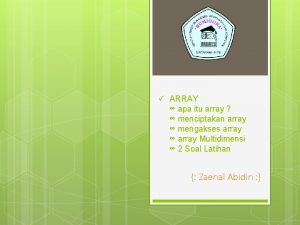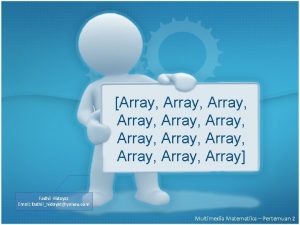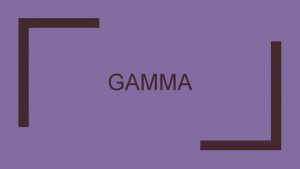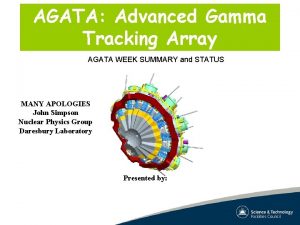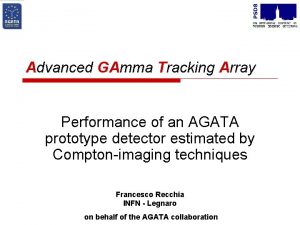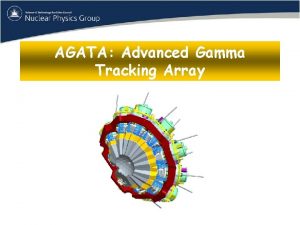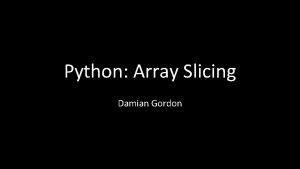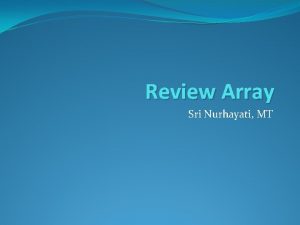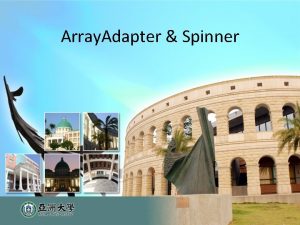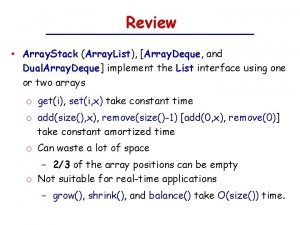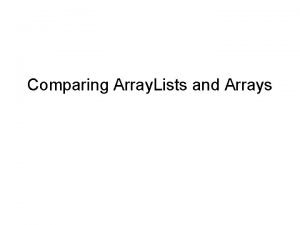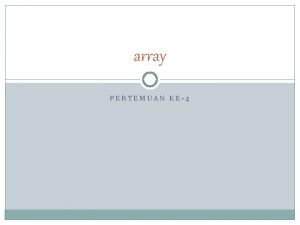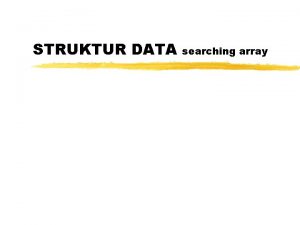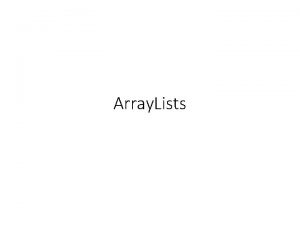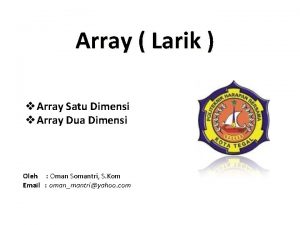What the Advanced Gamma Tracking Array can do











![Triple Cluster Energies: Single vs Triple C 002 – FWHM [ke. V] B 002 Triple Cluster Energies: Single vs Triple C 002 – FWHM [ke. V] B 002](https://slidetodoc.com/presentation_image_h2/7df34a39b0c4b76d923d107081833097/image-12.jpg)























- Slides: 35

What the Advanced Gamma Tracking Array can do for us AGATA PSD 8 Glasgow Nuclear science in the 21 st century http: //www. gsi. de/agata/ Andy Boston ajboston@liv. ac. uk

The Advanced Gamma Ray Tracking Array • Introduction: The AGATA project • Current status of AGATA – towards the “demonstrator” • Exploitation of AGATA – demonstrator and beyond AGATA PSD 8 Glasgow Next generation γ-ray spectrometer based on gamma-ray tracking First “real” 4 germanium array no Compton suppression shields Versatile spectrometer with very high efficiency and excellent spectrum quality for radioactive and high intensity stable beams

Experimental conditions and challenges AGATA PSD 8 Glasgow FAIR SPIRAL 2 SPES REX-ISOLDE EURISOL ECOS • • • Low intensity High backgrounds Large Doppler broadening High counting rates High -ray multiplicities Need instrumentation High efficiency High sensitivity High throughput Ancillary detectors

Long Range Plan 2004 Recommendations and priorities … In order to exploit present and future facilities fully and most efficiently, advanced instrumentation and detection equipment will be required to carry on the various programmes. The project AGATA, for a 4 -array of highly segmented Ge detectors for -ray detection and tracking, will benefit research programmes in the various facilities in Europe. Nu. PECC gives full support for the construction of AGATA and recommends that the R&D phase be pursued with vigour.

AGATA (Advanced GAmma Tracking Array) 4 -array for Nuclear Physics Experiments at European accelerators providing radioactive and high-intensity stable beams Main features of AGATA Efficiency: 43% (M =1) 28% (M =30) today’s arrays ~10% (gain ~4) Peak/Total: 58% (M =1) today ~55% 5% (gain ~1000) 49% (M =30) 40% Angular Resolution: ~1º FWHM (1 Me. V, v/c=50%) ~ 6 ke. V !!! today ~40 ke. V Rates: 3 MHz (M =1) 300 k. Hz (M =30) AGATA PSD 8 Glasgow today 1 MHz 20 k. Hz • 180 large volume 36 -fold segmented Ge crystals in 60 triple-clusters • Digital electronics and sophisticated Pulse Shape Analysis algorithms allow operation of Ge detectors in position sensitive mode -ray tracking

The AGATA Organisation AGATA Steering Committee Chairperson: W. Korten (and EURONS) Vice Chairperson: P. J. Nolan G. de. Angelis, A. Atac, F. Azaiez, D. Balabanski, D. Bucurescu, B. Cederwall, J. Gerl, J. Jolie, R. Julin, W. Meczynski, , M. Pignanelli, G. Sletten, P. M. Walker AGATA Management Board J. Simpson (Project Manager) D. Bazzacco, G. Duchêne, P. Reiter, A. Gadea, J. Nyberg, Ch. Theisen AGATA Working Groups Detector module P. Reiter Front-end Processing D. Bazzacco Data Acquisition Ch. Theisen Design and Infrastructure G. Duchêne Ancillary detectors and integration A. Gadea Simulation and Data Analysis J. Nyberg AGATA Teams Detector and Cryostat A. Linnemann Digitisation P. Medina Data acquisition X. Grave Mechanical design J. Strachan Elec. and DAQ integration P. Bednarczyk Gamma-ray Tracking A. Lopez-Martens Preamplifiers A. Pullia Pre-processing I. Lazarus Run Control & GUI G. Maron Infrastructure P. Jones Devices for key Experiments N. Redon Physics & exp. simulation E. Farnea Detector Characterisation A. Boston Global clock and Trigger M. Bellato R & D on gamma Detectors D. Curien Impact on performance M. Palacz Detector data base K. Hauschild Mechanical Integration J. Valiente Dobon Data analysis O. Stezowski PSA R. Gernhaeuser/ P. Desesquelles

Ingredients of -Tracking 1 Highly segmented HPGe detectors · · AGATA PSD 8 Glasgow 2 4 Identified interaction points (x, y, z, E, t)i Reconstruction of tracks e. g. by evaluation of permutations of interaction points Pulse Shape Analysis to decompose recorded waves 3 Digital electronics to record and process segment signals reconstructed -rays

AGATA array design AGATA PSD 8 Glasgow 3 different asymmetric hexagonal shapes are used Completed array (6480 segments) with support structure Triple cluster modular units in a single cryostat The AGATA demonstrator: 5 triple clusters, 540 segments. Scheduled for completion 2008 2 of completed array

Ingredients of -Tracking 1 Highly segmented HPGe detectors · · AGATA PSD 8 Glasgow 2 4 Identified interaction points (x, y, z, E, t)i Reconstruction of tracks e. g. by evaluation of permutations of interaction points Pulse Shape Analysis to decompose recorded waves 3 Digital electronics to record and process segment signals reconstructed -rays

AGATA 1 st symmetric capsule Hexaconical Ge crystals 90 mm long 80 mm max diameter 36 segments Al encapsulation 0. 6 mm spacing 0. 8 mm thickness 37 vacuum feedthroughs

AGATA PSD 8 Glasgow AGATA detector status • Symmetric detectors – 3 delivered • Asymmetric detectors – 19 ordered (9 accepted, 4 in test, 2 not accepted, 4 to be delivered) • Preamplifiers available – Core (Cologne); – Segment (Ganil & Milano) • Test cryostats for characterisation – 5 delivered • Triple cryostats – 5 ordered – 1 complete, 2 being assembled, 2 ordered
![Triple Cluster Energies Single vs Triple C 002 FWHM ke V B 002 Triple Cluster Energies: Single vs Triple C 002 – FWHM [ke. V] B 002](https://slidetodoc.com/presentation_image_h2/7df34a39b0c4b76d923d107081833097/image-12.jpg)
Triple Cluster Energies: Single vs Triple C 002 – FWHM [ke. V] B 002 – FWHM [ke. V] A 001 – FWHM [ke. V] Resolution 60 ke. V line Resolution 1. 33 Me. V line

Ingredients of -Tracking 1 Highly segmented HPGe detectors · · · Gamma-ray tracking arrays · 2 4 Identified interaction points (x, y, z, E, t)i Reconstruction of tracks e. g. by evaluation of permutations of interaction points Pulse Shape Analysis to decompose recorded waves 3 Digital electronics to record and process segment signals reconstructed -rays

Segment level processing: energy, time Detector level processing: trigger, time, PSA Global level processing: event building, tracking, software trigger, data storage

AGATA Digitiser Module 36+1 channels, 100 Mh. Z, 14 bits (Strasbourg - Daresbury – Liverpool) • Mounted close to the Detector 5 -10 m • Power Dissipation around 400 W • Water Cooling required • Tested in Liverpool (December 2006) • Production in progress (for 18 modules) Prototype Segment Board (2 boards per crystal)

Ingredients of -Tracking 1 Highly segmented HPGe detectors · · AGATA PSD 8 Glasgow 2 4 Identified interaction points (x, y, z, E, t)i Reconstruction of tracks e. g. by evaluation of permutations of interaction points Pulse Shape Analysis to decompose recorded waves 3 Digital electronics to record and process segment signals reconstructed -rays

Detector Characterisation and PSA AGATA PSD 8 Glasgow • • Calibrate detector response function Comparison of real and calculated pulse shapes Coincidence scan for 3 D position determination Validate codes “How well your basis fits your real data”

AGATA PSD 8 Glasgow AGATA detector scanning

Azimuthal detector sensitivity r = 24 mm z = 7. 3 mm = 171. 9 o F 1 E 1 A 1 0 o D 1 B 1 AGATA PSD 8 Glasgow C 1

Electric Field Simulations : MGS I Geometry II Potential Elec field III Drift velocities AGATA symmetric crystal simulation IV Weighting fields • Electric field simulations have been performed and detailed comparisons have been made with experimental pulse shape data.

AGATA PSD 8 Glasgow Experiment vs Theory Performance

Status of the PSA 3 types of codes: • Whole crystal with multi-hits per segment – Genetic algo. (Padova, Munich) – Swarm algo. (Munich) – Adaptative grid search (Padova) – Matrix method (Orsay) • Single-hit in one segment – Binary search (Darmstadt) – Neural network (Munich, Orsay) • Determination of the number of hits – Recursive subtraction (Milan) – Matrix method (Orsay)

Pulse-Shape Analysis: current status Results from the analysis of an in-beam test with the first triple module, e. g. Doppler correction of gamma-rays using PSA results d(48 Ti, p)49 Ti, v/c ~6. 5% Results obtained with Grid Search PSA algorithm (R. Venturelli et al. ) Position resolution ~4. 4 mm

Ingredients of -Tracking 1 Highly segmented HPGe detectors · · AGATA PSD 8 Glasgow 2 4 Identified interaction points (x, y, z, E, t)i Reconstruction of tracks e. g. by evaluation of permutations of interaction points Pulse Shape Analysis to decompose recorded waves 3 Digital electronics to record and process segment signals reconstructed -rays

The “Standard” Germanium Shell Digital Spectroscopy and Imaging Idealized configuration to determine maximum attainable performance Ri = 15 cm Ro = 24 cm 230 kg of Ge M = 1 A high multiplicity event E = 1. 33 Me. V M = 30 eph = 65% P/T = 85% M = 30 eph = 36% P/T = 60% Assuming 5 mm Position Resolution 27 gammas detected -- 23 in photopeak 16 reconstructed -- 14 in photopeak

AGATA Design and Construction 180 geometry defined Conceptual design of 180 array done Specifications of infrastructure parts done Design of AGATA demonstrator for LNL complete Flanges manufactured Assembly in LNL, complete

The First Step: The AGATA Demonstrator Objective of the final R&D phase 2003 -2008 1 symmetric triple-cluster 5 asymmetric triple-clusters 36 -fold segmented crystals 540 segments 555 digital-channels AGATA PSD 8 Glasgow Eff. 3 – 8 % @ M = 1 Eff. 2 – 4 % @ M = 30 Full ACQ with on line PSA and -ray tracking Cost ~ 7 M €

Commissioning Preliminary Plan - Phase 0: commissioning with radioactive sources starting when detectors and electronics are available (even partially). - Phase 1: easy test with tandem beams with no ancillary detectors. Radiative capture or fusion-evaporation reactions with light targets in inverse kinematics. - Phase 2: test with a “simple” ancillary detector with limited number of parameters (DANTE). Coulomb excitation reactions with medium mass beams (A<100) in inverse kinematics. - Phase 3: test with PRISMA with multi-nucleon transfer reactions and at high multiplicity with appropriate ancillaries. The earliest possibility to run in-beam tests is Dec. 2008

AGATA Demonstrator at PRISMA

AGATA Experimental Program 2008 LNL 6 TC 2010 GANIL/SPIRAL ≥ 8 TC 2012 GSI / FRS ~15 TC (1 ) AGATA @ FRS AGATA D. + PRISMA Eff (%) vs. distance AGATA radius 23. 5 cm 6% AGATA D. LNL 13. 5 cm AGATA + VAMOS AGATA D. ≥ 8 TC EXOGAM 8 seg. Clovers Total Eff. > 10% Setup works also as Compton Polarimeter b = 0. 5

Scientific programme: Grazing reactions transferring several nucleons: evolution of magic numbers and collectivity in n-rich nuclei, but not only. . . Proton More than 20 Lo. I: protons Highly Excited Collective Modes. Proton rich mirror nuclei populated by transfer reactions. Superdeformed states in A~40 protonrich nuclei. neutrons drip-line Neutron drip -line Order-Chaos transition in Warm rotating nuclei. Evolution of collectivity and Dynamical Symmetries in the rare earths Mix-symmetry states Quenching of the N=82 shell gap in n-rich nuclei N=50 shell gap: lifetime, and excited states Spectroscopy and lifetimes in the new region of deformation n-rich A~60, N~40 nuclei Lifetimes in the region of the island of inversion

AGATA demonstrator at GANIL (~2010/11) Main physics opportunities: • Spectroscopy of heavy elements towards SHE • Gamma-ray spectroscopy of neutron-rich nuclei populated in Deep Inelastic Reaction (with the GANIL specific aspects) • Gamma-ray spectroscopy with reactions at intermediate energies (up to 50 A. Me. V) • Classical high-spin physics and exotic shapes Range of beams, fragmentation, SPIRAL, direct beam line

AGATA “post-demonstrator” array at GSI-FRS (~2012/13) Main physics opportunities: Gamma-ray spectroscopy with reactions • at relativistic energies (> 50 A. Me. V) Coulomb excitation, few nucleon removal etc. • with slowed-down beams (10 -20 A. Me. V) direct reactions, inelastic scattering


What the Advanced Gamma Tracking Array can do for us AGATA PSD 8 Glasgow Nuclear science in the 21 st century http: //www. gsi. de/agata/ Andy Boston ajboston@liv. ac. uk
 Photovoltaic array maximum power point tracking array
Photovoltaic array maximum power point tracking array Delacons
Delacons North bridge south bridge
North bridge south bridge Deklarasi array x adalah double a 2 4 5
Deklarasi array x adalah double a 2 4 5 Jagged array vs multidimensional array
Jagged array vs multidimensional array Associative array vs indexed array
Associative array vs indexed array Difference between broadside array and endfire array
Difference between broadside array and endfire array Larik
Larik Sparse array adalah
Sparse array adalah Contoh array 1 dimensi dan 2 dimensi
Contoh array 1 dimensi dan 2 dimensi Hình ảnh bộ gõ cơ thể búng tay
Hình ảnh bộ gõ cơ thể búng tay Bổ thể
Bổ thể Tỉ lệ cơ thể trẻ em
Tỉ lệ cơ thể trẻ em Gấu đi như thế nào
Gấu đi như thế nào Tư thế worms-breton
Tư thế worms-breton Chúa sống lại
Chúa sống lại Môn thể thao bắt đầu bằng từ đua
Môn thể thao bắt đầu bằng từ đua Thế nào là hệ số cao nhất
Thế nào là hệ số cao nhất Các châu lục và đại dương trên thế giới
Các châu lục và đại dương trên thế giới Công của trọng lực
Công của trọng lực Trời xanh đây là của chúng ta thể thơ
Trời xanh đây là của chúng ta thể thơ Mật thư anh em như thể tay chân
Mật thư anh em như thể tay chân Phép trừ bù
Phép trừ bù độ dài liên kết
độ dài liên kết Các châu lục và đại dương trên thế giới
Các châu lục và đại dương trên thế giới Thơ thất ngôn tứ tuyệt đường luật
Thơ thất ngôn tứ tuyệt đường luật Quá trình desamine hóa có thể tạo ra
Quá trình desamine hóa có thể tạo ra Một số thể thơ truyền thống
Một số thể thơ truyền thống Cái miệng nó xinh thế
Cái miệng nó xinh thế Vẽ hình chiếu vuông góc của vật thể sau
Vẽ hình chiếu vuông góc của vật thể sau Biện pháp chống mỏi cơ
Biện pháp chống mỏi cơ đặc điểm cơ thể của người tối cổ
đặc điểm cơ thể của người tối cổ V cc cc
V cc cc Vẽ hình chiếu đứng bằng cạnh của vật thể
Vẽ hình chiếu đứng bằng cạnh của vật thể Vẽ hình chiếu vuông góc của vật thể sau
Vẽ hình chiếu vuông góc của vật thể sau
